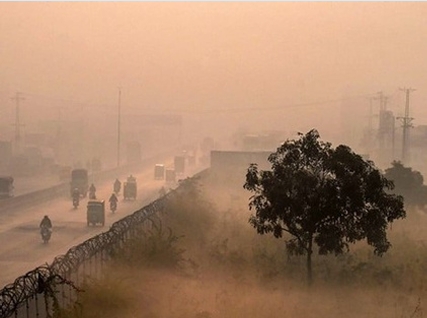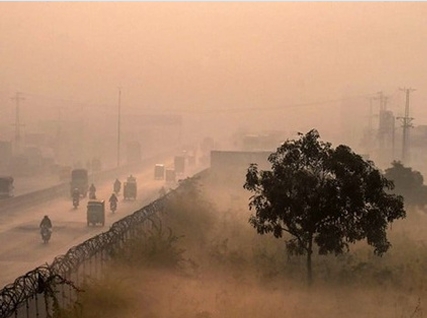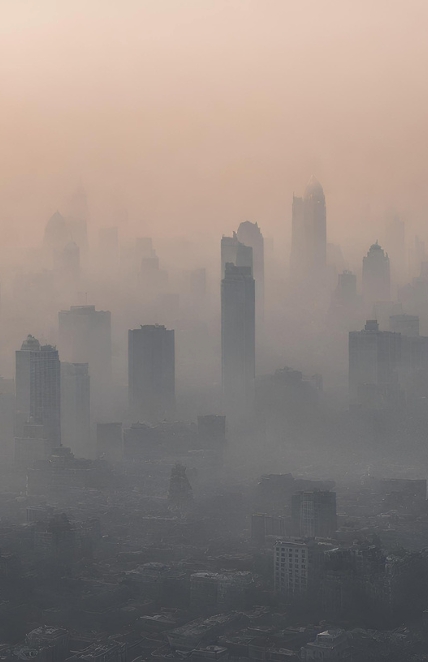
by Kinza Saeed
Climate change is causing significant changes in our environment, one of which is smog. Smog happens when pollutants mix with the air we breathe, creating a thick fog-like haze. The rise in global temperatures due to climate change makes smog worse by increasing the production of pollutants. Smog can cause health problems like respiratory issues, eye irritation, and even heart conditions. It is crucial to address climate change to reduce smog and protect our health and the environment.

Smog Impact on Climate and Health
Smog is like a silent intruder, sneaking into our atmosphere and causing trouble without being noticed. It is a type of air pollution made up of smoke and fog, thus called “smog”. This is not just any fog, it is a harmful mix of pollutants that can have serious consequences for both the environment and our health. It poses threat to public health, with its complex mixture of pollutants contributing to a range of adverse effects. Initially formed from vehicular emissions, industrial activities, and other burning processes, smog carries harmful substances like ozone, nitrogen dioxide, sulfur dioxide, and fine particulate matter. These pollutants can cause serious risks of the respiratory system, causing symptoms such as coughing, wheezing, and shortness of breath, and deadly conditions like asthma and COPD.
Moreover, the detrimental impact of smog encompasses beyond the lungs, causing serious cardiovascular diseases like heart attacks and strokes, as well as neurological disorders such as Alzheimer’s and Parkinson’s disease. Pregnant women and their unborn children are particularly vulnerable, facing risks of preterm birth and developmental issues. The universal influence of smog even extends to reducing the quality of life, hindering outdoor activities, and diminishing overall well-being. Breathing in smoggy air can be harmful, especially for children, the elderly, and those with respiratory issues like asthma or bronchitis. Smog can cause or worsen breathing problems, coughing, throat irritation, and even more severe respiratory diseases. Long-term exposure to smog has been linked to heart disease, lung cancer, and premature death.
Addressing this urgent health crisis requires collaborative efforts to reduce emissions and implement severe air quality regulations, safeguarding both current and future generations from the perils of smog-induced health hazards.
What Creates Smog?
The main culprits behind smog are pollutants released from burning fossil fuels like coal, oil, and gas. When these fuels are burned in cars, factories, power plants, and even in our homes, they release harmful gases like nitrogen oxides and volatile organic compounds into the air. When these gases react with sunlight, they form ground-level ozone, the primary component of smog.
The Impact on Climate
Smog is not just a local issue; it contributes significantly to global climate change. The gases and particles in smog trap heat in the atmosphere, leading to increased temperatures, a phenomenon known as the greenhouse effect. This warming of the Earth’s surface disrupts weather patterns, melts polar ice caps, and contributes to rising sea levels, endangering ecosystems, and wildlife.

Steps to Reduce Smog
Cutting Emissions We can reduce smog by using cleaner forms of energy, like solar or wind
power, and improving fuel efficiency in vehicles.
Public Transport and Carpooling Opting for public transport, walking, or carpooling can lessen the number of vehicles on the road, reducing smog-forming emissions.
Planting Trees Trees help by absorbing some of the pollutants and producing oxygen, improving air quality.
Supporting Regulations Governments can implement and enforce stricter regulations on industries and vehicles to limit emissions and control smog. Smog might be invisible, but its impact on our climate and health is very real. It is a problem that affects us all, regardless of where we live. By reducing our reliance on fossil fuels and advocating for cleaner air policies, we can work together to clear the air, protect our planet, and ensure a healthier future for everyone.
_______________________
The author is a student of BS Mass Communication at the Women University Multan.

